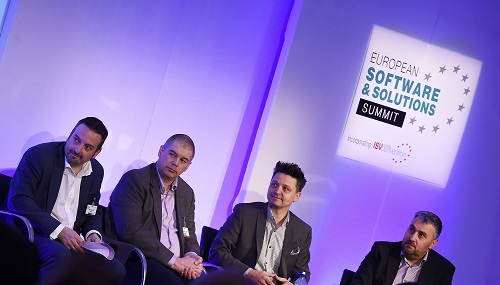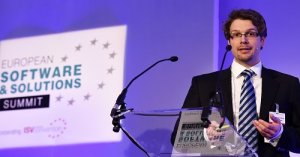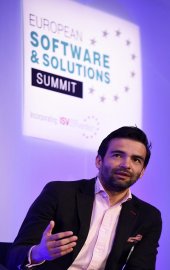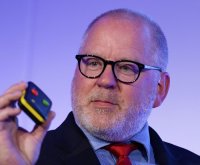 The IT Europa event, the European Software and Solutions Summit, now in its ninth year, found ISVs and others faced with major decisions
The IT Europa event, the European Software and Solutions Summit, now in its ninth year, found ISVs and others faced with major decisions The ISV market is at a cross-roads in 2016, with new models emerging and a driving pressure from customers anxious for changes in their competitiveness. The European Software and Solutions Summit 2016 ranged over issues as varied as cognitive computing, the emergence of ISVs from within enterprises to licensing and the timeframe for a successful software company buy-out.
The scene was set with a view of the trends in the software industry by Frost & Sullivan's Martin Hoff ter Heide (below). Among the various issues was the increasing monetisation of personal data on the part of consumers, and the building of micro-income streams of businesses. He highlighted the impact of technology-driven change in Europe, including the loss in mid-income jobs in Europe from automation. This affects national economies while driving big changes in education; systems are continually applied for further cost reduction, he says which drives further need for IT-based solutions.
There is a lot going on and an increasing rate of change in software. While technology advances have brought trends such as internet of things, and this is linked to trends such as smart manufacturing, at the same time, there is a change in how IT is being used, with many lessons coming in from the consumer side on ease of use and interfaces

"Most of these trends are really broad, but some, such as energy management, are more specific, but capable of changing other areas with upstream and downstream ideas. It all gets a lot of wider," he said.
"Watching our megatrends, We also see things as they accelerate at a particular point in time, and driving investment. In 2016 we recognise the loss of middle income jobs – while there are gains in high paid jobs, there have been a significant reduction in others – a hollowing out of the middle classes, affect by automation and smart manufacturing. And this process is set to continue, with an impact on spending, and cut costs to save money, while generating additional revenue streams. This is creating a sharing economy – using services rather than buying a car, renting our spare rooms."
Creating additional revenue streams is a part of concepts emerging in IT – monetising data and offering consumers incentives. The drivers for this are the data tools becoming available. Data also allows providers such as those in healthcare to offer more options.
Funding as a way to raise funds is another area of interest to software companies, and this is growing fast, he said. There are some big names moving to use technology in financial technology – using cost advantages and adding scale. They have to do this to reduce the threat of smaller competitors. The use of encryption and cryptography also means that any digital asset can be put into the marketplace using systems that generate trust and this can replace a lot of brokers and people validating transactions. Cross-border payments is one example of this.
The strands of these trends include consumer technology which is playing an inspiring role in other activities, and in learning processes. Augmented reality means layering extra information on top of reality and this is starting to become a key trend in 2016, starting in medical uses, with other uses including professional training. These things are hot and happening in consumer space and this will mean that 2016 is already another year where IT is boosted by the consumer world.
Data is rising to prominence as a key source of value and foundation for business models; on top of this security is becoming absolutely essential. Software is eating the world; and we have also seen that it is becoming a whole lot smarter which takes us back to a megatrend – artificial intelligence is already here, and around us in a narrow and task specific form as software. There is a high innovation potential remaining here, he concluded.
The power of IT used for data analysis was a point well-made by IBM Watson's EMEA head, Paul Chong (below, left), with many examples of its transforming nature and the scale of resources invested in it. The use of the term cognitive computing was picked up and he explained that AI term was still associated with robots, with negative reactions. The power of Watson is available for ISVs to explore for themselves, at no cost, as some indicated that they were already using it.

"Decomposing the technology, we are providing it within the platform, and it is being made available through an API economy, creating innovation and cognitive system to create better outcomes. The opportunity exists for everyone. We are asking developers ans ISV to engage with our technology. They can be used to improve systems in so many areas," he said.
IT is much easier to manage and deliver change on SaaS, he said, and was how IBM was working, itself. "It is a cultural shift – we are asking customers to focus on the disruption that will happen in their businesses. As an ISV – who are you talking to ? Talking to IT [departments] gets into a trivial debate on technology. But technology is a disrupter and catalyst for change-you need to have that conversation with many different people."
Brussels-based Paul MacDonnell (below, right), from think-tank The Centre for Data Innovation is a close watcher of how the EU is moving towards data compliance and he was able to position how Europe, while being well placed in terms of skills and having succeeded in many technology areas, somehow fails to get coherence in terms of establishing standards. This may be because of a sense of distrust of the US giants, but, he said, “Europe is not going to produce a Google or Facebook”. It would do better to specialise in areas where it can make progress. "There are signs that regulators want to treat data as a currency in order to negotiate with – some think this is then like a consumer transaction, which create problems with those free services, using freemium and the like."

"I predict this will become a significant issue - some regulators are taking the view that firms in possession of large amounts of data are in a position to dominate and impose unfair terms. Reading papers on this area, we think there is a challenge to companies. These are potential problems, because once the regulators decide that data is a medium of exchange – and the golden age of free data interchange will be over. A precautionary principle which is driving the institutions in Europe could lead to a problem for the data industry – death by by a thousand cuts," he warned.
Every company is a software company, believes coMakeIT's CEO Steven ten Napel. He viewed this not so much as adding competitors to the ISV sector, but from the way almost every business and organisation is driven by applications and IT processes that it has created and understands. But the only way forward for ISVs of all types would be a wider ecosystem of supporters and partners. This is a cross-roads for the ISV, he explained, as they had to decide how to move forward in co-operation, in a market where skills would be scarce and the pace of development was picking up.
The well-attended breakouts covered the use of IoT and big data by ISVs, from presenters NaviSite and Panintelligence. ISVs were shown higher-margin alternatives to Oracle by Tmaxsoft's UK MD Carl Davies, with IBM's ISV Business leader Bob Suter talking about new tools for ISVs to help the SaaS conversion, which will become available in the next few days.
The final rousing keynote was given by M&A specialist Hampleton's senior director David Riemenschneider (below), who highlighted the IT sectors with highest valuations, while also warning that it was sometimes less profitable to wait until a more mature business could be built; even early starters and start-ups can find a market, he advised and pointed to 2016 being a very successful year for activity.

The successful day concluded with a roundtable where speakers were hesitant to lay down any hard and fast guides to how the industry would be in the future, even in just a year's time, but which was optimistic and looking forward to the next event.